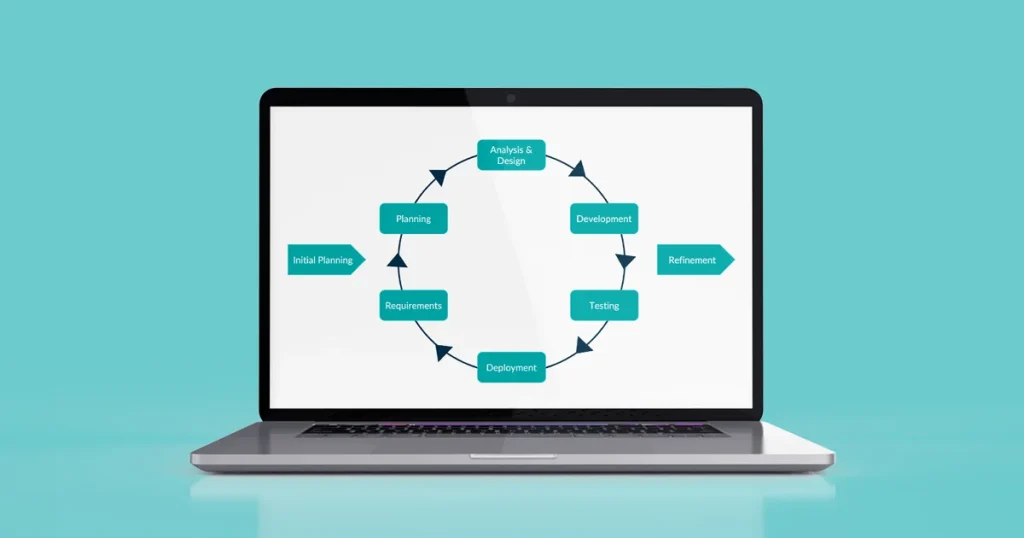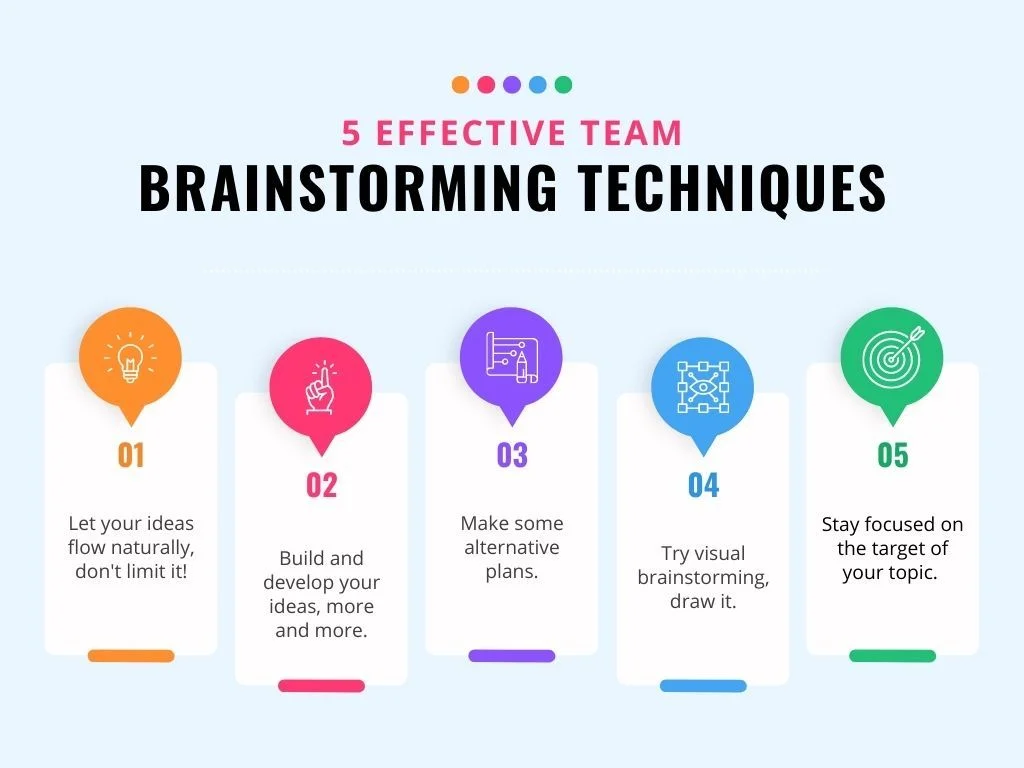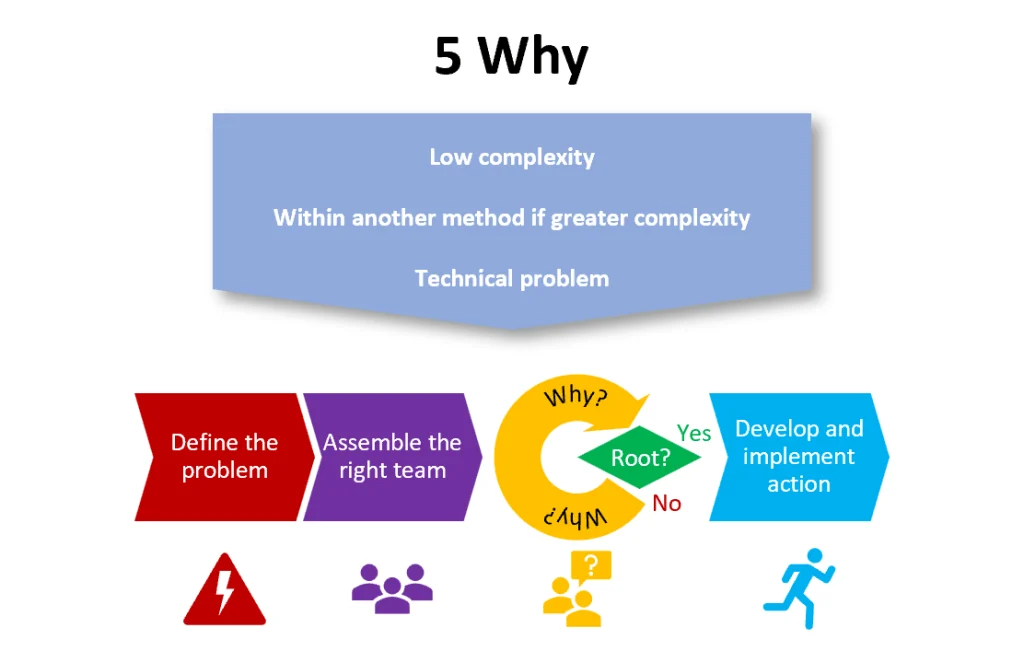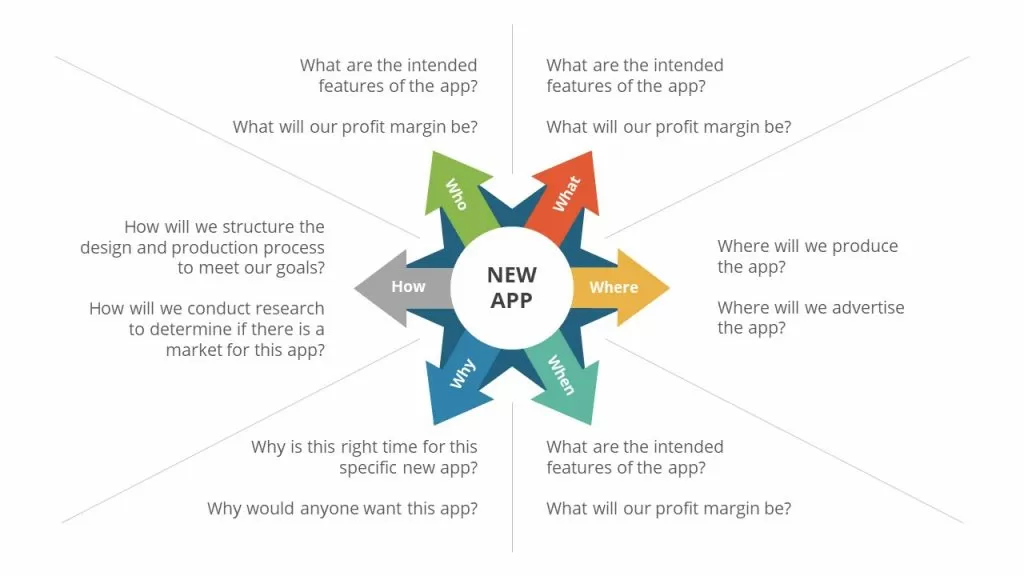Definition of Brainstorming
Brainstorming is a group technique that fosters creativity by generating many ideas to solve a problem. It requires participants to think freely and come up with as many suggestions as possible, even if they are unusual.
Purpose of Brainstorming
- Produce Ideas: Brainstorming enables people to generate numerous ideas quickly, allowing them to explore multiple solutions or concepts.
- Foster Creativity: It creates an atmosphere where people feel free to think outside the box, leading to unconventional and innovative ideas beyond ordinary limits.
- Encourage Collaboration: Involving several individuals brings about team spirit and sharing different views, working together to achieve common goals.
- Find Solutions: Considering various approaches and potentialities helps identify novel answers to problems.
- Increase Engagement: The active involvement of participants during brainstorming makes them more interested in finding solutions, thus improving their commitment to the problem-solving process.
The Significance of Brainstorming among Teens
Inspires Creative Thinking
Brainstorming is critical for nurturing creative thinking among teenagers. Through these sessions, teens are challenged to step out of their comfort zones and come up with unique thoughts,, ultimately leading toventiveness when solving problems or dealing with different situations tharequiringch skills.
Develops Problem-Solving Abilities
Participating in activities that involve brainstorming enhances problem-solving abilities in adolescents. This allows them to consider various perspectives or ways of approaching a given situation, thereby resulting in better solutions as this may expose one’s mind to looking at things from multiple angles, which might not have been realized earlier on.
Otherwise leading only limited viewpoints being generated through critical analysis necessary for academic excellence but also personal growth since life presents us with diverse challenges.

Promotes Team Work and Collaboration
Brainstorming sessions often require groups to work together, thus helping teens develop skills in teamwork and collaboration. Jointly generating ideas with others teaches them how important it is to listen attentively when someone else speaks.
Respect other people’s opinions even if they differ from ours, and build upon each other’s contributions towards achieving common objectives through communication.
How to Enhance Brainstorming Skills among Teens
Encourage free sharing of thoughts.
Create an atmosphere where teenagers can freely express their views without feeling judged. When individuals feel accepted for who they are, they become more confident in themselves, promoting positive thinking among peers, leading to the exchange of different ideas and sparking creativity.
At the same time, active listening skills should be taught since this helps one understand another person better, thus fostering trust among members within a group, as well as showing appreciation for diverse talents or abilities possessed by different individuals.
Introduce Different Approaches
Teach various methods such as mind mapping, free writing, or role-playing during brainstorming lessons so that teenagers may experiment with what works best for them based on personal thinking styles.
These techniques activate various parts of the brain responsible for imaginative thinking, thereby keeping the process lively and exciting besides equipping young people with multiple problem-solving tools.

Encourage Joint Endeavors
Involve adolescents in projects that necessitate collective problem-solving. Such undertakings enable them to appreciate team spirit while at the same time valuing diverse viewpoints.
Working together towards common goals improves communication skills among peers, which includes learning how to compromise when necessary as well as recognizing strengths present in others, thereby resulting in more vital, more creative solutions.
Give Real-Life Problems
Make the event more applicable and influential by getting young people to engage with real-life problems for idea generation. This method nurtures critical thinking and enables them to put their thoughts into practice. It also demonstrates to teenagers that their contributions matter, as well as the potentiality of actual changes happening around them.
Besides, setting their sights on real-world issues ensures that brainstorming sessions are inspiring and not mere time fillers; they equip them with skills necessary for personal or professional life where they have to solve problems.
Create a Secure Environment

It is essential that the place where ideas are shared during a brainstorming session is safe and supportive. Positive reinforcement assists teenagers in developing confidence in their ability to come up with creative solutions.
When the atmosphere is non-judgmental, learners can freely express themselves without fear of being mocked, thus allowing for constructive criticism, which may help improve on initial suggestions made during such gatherings.
More so, creating safe spaces encourages risk-taking, which is crucial in fostering creativity because people will be free enough to try out new things even if they don’t know whether these attempts will succeed or not.
Benefits of Brainstorming

Promotes Originality
The freedom for participants’ minds to wander and propose any idea under the sun is what makes brainstorming an effective tool for promoting original thought. Such a process breaks individuals away from their usual way of thinking, thereby enabling them to generate unique solutions by coming up with new perspectives toward various matters at hand.
In addition, by ensuring that all judgments are postponed until later stages when evaluating alternatives, this method acts as a catalyst for creative thinking while opening up opportunities that might have otherwise been ignored due to a lack of imagination or fear of being wrong.
Enhances Collaboration within Teams
Brainstorming fosters collaboration among team members because it involves every member in generating ideas. This approach encourages sharing diverse views and experiences, which can lead to better quality suggestions than when one person does all the thinking alone.
Moreover, working together during a session creates trust between participants who may have different backgrounds or personalities, thus making them appreciate each other’s contributions more and building stronger bonds between them.
Sparks Breakthrough Innovations
Another advantage of brainstorming is its ability to spark breakthrough innovations by coming up with fresh insights into problems. The inclusive nature of this exercise allows for the exploration of various concepts, some of which could be revolutionary in terms of solving specific issues.
Such potential for newness becomes particularly useful during problem-solving processes where strategic plans require that people think beyond what already exists so as to make significant advances toward desired outcomes.
Brings Forth Different Points of View
Different perspectives are brought forth by brainstorming since individuals from different backgrounds are involved. This ensures that solutions arrived at take into account multiple angles and considerations, thereby resulting in a more robust final decision or solution.
Therefore, through the integration of these various viewpoints, it becomes evident that an outcome will be effective because all relevant aspects have been considered beforehand, thus leaving nothing to chance.
Idea Generation in Large Numbers within a Short Time
Brainstorming enables large numbers of ideas to be generated within a short period due to the fast thinking rate associated with it. When participants know they have limited time, there tend to be quick succession thoughts leading to a high number of suggestions being made during such sessions.
With many alternatives available, a refining process can take place to identify the best ways to tackle the challenges faced by individuals or organizations.
Types of Brainstorming Techniques
Reverse Brainstorming Method
The reverse brainstorming technique involves considering how the cause rather than solving the problem would work. By looking at ways to create opposite desired outcomes, potential difficulties may become apparent since solutions would involve looking at what should not happen from another angle altogether until things become clear enough on how best to achieve set goals under prevailing circumstances.
Random Word Approach
The random word approach entails picking any random word as a stimulus, generating fresh ideas related to the problem being addressed.
This method breaks normal thought patterns and enhances creativity since people are forced to make unusual connections between picked words and issues under discussion.
The 5 Whys Method
The process of asking “why” multiple times, usually about five, to get to the bottom of a problem is what the 5 Whys method involves.
By digging deeper into the initial problem over and over again, root causes can be discovered and dealt with more effectively so that solutions are more holistic.

SCAMPER Model
SCAMPER is an acronym for Substitute, Combine, Adapt, Modify, Put to another use, Eliminate, and Rearrange, which represents a technique used in coming up with fresh ideas by changing existing products or processes.
Creative thinking is prompted in every part of SCAMPER by testing the status quo against different perspectives.
Rapid Ideation
Generating as many ideas as possible within a set time limit is what rapid ideation entails. This technique emphasizes quantity rather than quality, thus challenging participants to think fast and freely without excessive analysis.
Once reviewed and refined, the large number of ideas generated can result in unexpected and innovative solutions.
Starbursting
Starbursting is a technique where, instead of answers, people generate questions about a particular topic. This approach ensures that all potential problems, opportunities, and challenges are considered while probing every angle of an idea.
A more thorough understanding and solution development becomes possible by addressing these queries.

Tips for Your Brainstorming Activities
Record All Ideas
During the brainstorming session, make sure you write down every idea. Not considering feasibility, capturing all suggestions will help preserve all aspects of creative thinking shown here.
Use sticky notes, whiteboard, or digital tools – anything works. Just ensure that it is comprehensive.
Ensure That Everyone’s Ideas Are Heard
Create an environment where everyone feels safe sharing their thoughts without judgment because this would lead to low self-esteem, among other things like fear, etc.
As such you should also encourage those who are shy in your team to speak up while listening actively yourself. The wider range of angles covered can bring about unique resolutions.

Focus on Quantity
In brainstorming, it is important to generate as many ideas as possible within a limited time instead of quality assessment. The aim should be to come up with different alternatives later for consideration, after which they may be improved upon where necessary.
This approach prevents early judgments from being made and nurtures innovation.
Mix It Up
To keep the session lively and interesting, incorporate different techniques during brainstorming. For instance, one could use mind maps, brainwriting, or even role-playing, among others, while this can trigger various forms of thought, which will break monotony in the process.
Avoid Criticism
Allow ideas to flow freely without immediate evaluation so that a judgment free zone is created. This way, people are able to come up with more open-ended suggestions since they know there won’t be any negative comments given at that moment, thus fostering creativity.
During the initial stage of brainstorming, only constructive feedback should be provided; criticisms can wait until later when reviewing whatever has been suggested already.
Conclusion
Brainstorming is an effective tool for enhancing creativity, collaboration, and problem-solving skills. By recording all ideas, ensuring inclusivity, focusing on quantity, mixing techniques, and avoiding criticism, you create an environment that stimulates innovative thinking.
Whether used in schools or offices, successful brainstorming methods have the potential to produce groundbreaking concepts and answers. Therefore, follow these hints to make your sessions as productive as possible, thereby promoting imaginative thinking.
FAQs
What is brainstorming?
It is a group method of generating numerous solutions to a problem quickly through participation by members.
Why is brainstorming important for teens?
At this age, being able to think outside the box becomes crucial not only because it helps with analytical reasoning but also due to its impact on enhancing their self-esteem alongside other social aspects like teamwork, etc.
What are a few of the most widely used ways to brainstorm?
Reverse brainstorming, random word brainstorming, 5 Whys method, SCAMPER technique de bono rapid ideation starbursting
How do I make sure that everyone’s ideas get heard during a brainstorming session?
Make it safe for people by creating an inclusive environment where they can share their thoughts without fear of being criticized.
Why do we do this thing called brainstorming?
In order to come up with many different ideas and solutions, we must think creatively together.

Russell F. Jones, holding a Master in psychology from the University of Florida. He writes for Smart Parent Solutions, offering practical advice on parenting and child development. His engaging content helps parents navigate family life with confidence and ease. Russell enjoys sharing his knowledge and spending quality time with his family.
